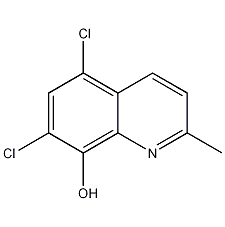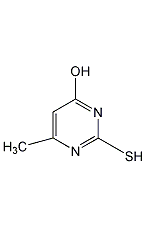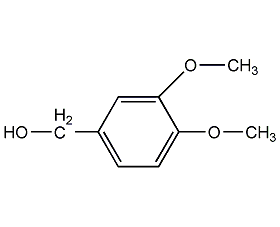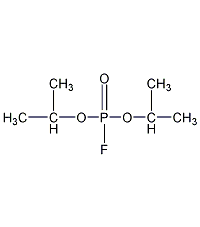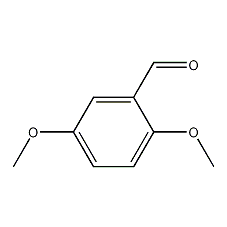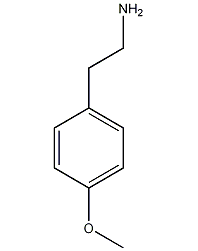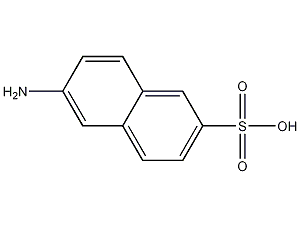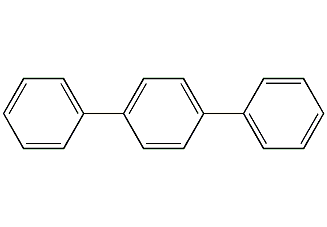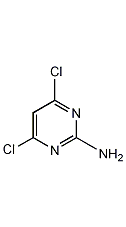
Structural formula
| Business number | 0174 |
|---|---|
| Molecular formula | C4H3Cl2N3 |
| Molecular weight | 164 |
| label |
2-amino-4,6-dichloropyrimidine |
Numbering system
CAS number:56-05-3
MDL number:MFCD00006090
EINECS number:200-253-9
RTECS number:UV6260485
BRN number:118454
PubChem number:24846101
Physical property data
1. Properties: white crystal, industrial product is light yellow solid.
2. Density (g/mL, 25/4℃): Undetermined
3. Relative vapor density (g/mL, air=1): Undetermined
4. Melting point (ºC): 223~225
5. Boiling point (ºC, normal pressure): Undetermined
6. Boiling point (ºC, 5.2kPa): Undetermined
7. Refractive index: Undetermined
8. Flash point (ºC): Undetermined
9. Specific rotation (º): Undetermined Determined
10. Autoignition point or ignition temperature (ºC): Not determined
11. Vapor pressure (kPa, 25ºC): Not determined
12. Saturated vapor pressure (kPa, 60ºC): Undetermined
13. Heat of combustion (KJ/mol): Undetermined
14. Critical temperature (ºC): Undetermined
15. Critical pressure (KPa): Undetermined
16. Log value of oil-water (octanol/water) partition coefficient: Undetermined
17. Explosion upper limit ( %, V/V): Undetermined
18. Lower explosion limit (%, V/V): Undetermined
19. Solubility: Insoluble in water, soluble in acetone, Dichloroethane and hot toluene.
Toxicological data
1. Acute toxicity: Rat oral LDLo: 1500mg/kg
Ecological data
None
Molecular structure data
1. Molar refractive index: 36.46
2. Molar volume (cm3/mol): 102.0
3. Isotonic specific volume (90.2K ): 293.1
4. Surface tension (dyne/cm): 68.0
5. Polarizability (10-24cm3): 14.45
Compute chemical data
1. Hydrophobic parameter calculation reference value (XlogP): 1.8
2. Number of hydrogen bond donors: 1
3. Number of hydrogen bond acceptors: 3
4. Number of rotatable chemical bonds: 0
5. Number of tautomers: 2
6. Topological molecular polar surface area (TPSA): 51.8
7. Number of heavy atoms: 9
8. Surface charge: 0
9. Complexity: 89.8
10. Number of isotope atoms :0
11. Determine the number of atomic stereocenters: 0
12. Uncertain number of atomic stereocenters: 0
13. Determine the number of chemical bond stereocenters Number: 0
14. Number of uncertain chemical bond stereocenters: 0
15. Number of covalent bond units: 1
Properties and stability
None
Storage method
This product should be kept sealed.
Synthesis method
Add 2-amino-4,6-dihydroxypyrimidine, phosphorus oxychloride and dichloroethane to the reaction kettle. After heating to 80ºC, add the triethylamine and dichloroethane solution dropwise to the reaction solution. The dropping time For more than 1 hour, reflux the mixture at 80~84ºC for 2 hours, add water to dissolve, filter, wash and dry to obtain the finished product.
Purpose
Mainly used for the preparation of intermediates of 2-amino-4,6-dimethoxypyrimidine and 2-amino-4-methoxy-6-chloro-pyrimidine.
extended-reading:https://www.newtopchem.com/archives/44704extended-reading:https://www.bdmaee.net/wp-content/uploads/2022/08/N-cyclohexyl-N-methylcyclohexylamine-CAS-7560-83-0-N-methyldicyclohexylamine.pdfextended-reading:https://www.bdmaee.net/wp-content/uploads/2022/08/Polyurethane-Catalyst-A33-CAS280-57-9-foaming-catalyst.pdfextended-reading:https://www.newtopchem.com/archives/1025extended-reading:https://www.newtopchem.com/archives/1824extended-reading:https://www.bdmaee.net/wp-content/uploads/2022/08/Dibutyltin-acetate-CAS1067-33-0-tributyltin-oxide.pdfextended-reading:https://www.morpholine.org/n-dimethylaminopropyldiisopropanolamine/extended-reading:https://www.bdmaee.net/fomrez-ul-22-catalyst-momentive/extended-reading:https://www.newtopchem.com/archives/1059extended-reading:https://www.bdmaee.net/wp-content/uploads/2022/08/134-6.jpg

